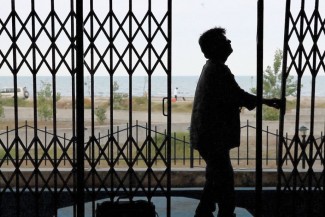Closed Curtain (Jafar Panahi, Kambuzia Partovi, 2013): Iran
Reviewed by Gabriella Baez. Reviewed at the AFI Film Festival, Los Angeles.
“Closed Curtain” directed by Jafar Panahi is a creative masterpiece and elaborate drama that takes. The most unique of all entries into the AFI festival was the international film selections of Iranian origin due to the restriction placed upon the director. Due to the oppressive and threatening government Panahi was sentenced to house arrest for six years and was band from making films for twenty years. In a similar situation is Mohammad Rasoulof who had his passport confiscated making him unable to speak on behalf of his film. Nevertheless, the Panahi was still able to produce films, one being titled “This is Not a Film” which was a documentary reflecting his house arrest.
In his new film “Closed Curtain” Panahi again attempts to describe the ridiculous restrictions on artists and the oppressive nature of the Iranian government. In the film the characters are a mirror image of the director’s house arrest. The main protagonist an older man (Partovi), is a screenwriter who is hiding away in a small house while he struggles to finish his latest story. The man’s best companion is a small dog that loyal follows him about the house. The country has begun to outlaw dogs and have been killing them off by the masses. The story shifts to panic when a brother and sister walk into the man’s house uninvited and claiming that they had been followed. The man claims he locked the door although the girl says that it was opened.
One of the most fascinating aspects of the director’s incorporation of elements of film is the combination of cinematography and editing. Both elements are of reoccurrence throughout the film and are repeated to emphasize the theme. The cinematography is manipulated by a relatively static camera that is far from uninteresting to the viewer. The single long shots are used for extended durations without moving impatiently from shot to shot. The opening scene consists of an extreme long shot that stations the camera inside of the window of the house looking out. By using the element the audience feels as if they have been confined because the setting doesn’t move out of the boundaries of the house. The editing in relation to the voice overs, are used to enhance the experience of the film by using verbal messaging rather than visual. It is expected the in a movie you see what is happen, but in this film often all you can do listen. The camera is very still and doesn’t pan. Many times during the film the characters will walk of screen but the camera doesn’t follow. The only way to know what is happening is to listen to the characters speaking off screen.
The ideology of the film bases its self on the psychological discharge of being oppressed. The film makes it evident that life is a constant struggle of what you can do and what you want to do. The ying and yang of finding the balance to ensure survival but also be daring enough to desire, is emphasized as two separate characters that are portrayed as extremists. Overall, I was pleasantly surprised at the overall creativity of the film and would like to have watched it a second time. With the additional information about the director, it is easier to understand the message being presented and appreciate the film as a piece of illegal art.
About this entry
You’re currently reading “Closed Curtain (Jafar Panahi, Kambuzia Partovi, 2013): Iran,” an entry on Student Film Reviews
- Published:
- 11.18.13 / 11pm
- Category:
- AFI Filmfest 2013, Films

3 Comments
Jump to comment form | comments rss [?] | trackback uri [?]